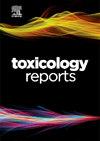苦楝种子乙醇提取物的抗肥厚作用。(姜黄科)抗异丙肾上腺素诱导的雄性Wistar大鼠心肌肥厚。
Q1 Environmental Science
引用次数: 0
摘要
苦楝种子被广泛用于心血管疾病的治疗。本研究旨在评价猪毛草种子乙醇提取物(EE)对大鼠心肌肥厚的预防作用。将异丙肾上腺素(0.3 mg/kg/天,sc)单独或与EE(37.5、75或150 mg/kg,每os)或心得安(20 mg/kg/天,每os)联合注射给雄性大鼠,连续7天测量收缩压(SBP)、舒张压(DBP)和心率。心脏匀浆检测髓过氧化物酶(MPO)、超氧化物歧化酶(SOD)、过氧化氢酶(过氧化氢酶)、一氧化氮(NO)和还原性谷胱甘肽(GSH)。同时,心脏组织切片用苏木精-伊红染色,马松三色染色,或用于房钠肽(ANP)的免疫组织学标记。异丙肾上腺素引起收缩压和舒张压下降(p本文章由计算机程序翻译,如有差异,请以英文原文为准。
Antihypertrophic effects of the seed ethanolic extract of Aframomum pruinosum Gagnep. (Zingiberaceae) against isoproterenol-induced cardiac hypertrophy in male Wistar rat
The seeds of Aframomum pruinosum are popularly used in the management of cardiovascular conditions. This study was undertaken to evaluate the capacity of the seed ethanolic extract of A. pruinosum (EE) to prevent the development of cardiac hypertrophy in rats. Isoproterenol (0.3 mg/kg/day, sc) was injected to male rats alone or concomitantly with EE (37.5, 75, or 150 mg/kg, per os) or propranolol (20 mg/kg/day, per os) for 7 consecutive days and systolic blood pressure (SBP), diastolic blood pressure (DBP), and heart rate measurements were performed. Cardiac homogenates were used to assay myeloperoxidase (MPO), superoxide dismutase (SOD), catalase, nitric oxide (NO) and reduced glutathione (GSH). Also, sections of heart tissue were stained with Hematoxylin-Eosin, Masson trichrome, or for immunohistological labelling of atrial natriuretic peptide (ANP). Isoproterenol administration caused a decline in SBP and DBP (p < 0.001). Heart rate, cardiac mass, cardiomyocyte surface, and MPO levels were significantly (p < 0.001) increased. All these alterations were significantly prevented (p < 0.01 and p < 0.001) by EE. EE inhibited immune cell infiltration and cardiac fibrosis elicited by isoproterenol injection. The overexpression of ANP in the atrium and ventricle induced by the isoproterenol was significantly (p < 0.001) prevented by EE. EE possesses antihypertrophic effect against isoproterenol-induced cardiac hypertrophy that may result from its antifibrotic, anti-inflammatory properties, as well as its capacity to down regulate the expression of ANP.
求助全文
通过发布文献求助,成功后即可免费获取论文全文。
去求助
来源期刊

Toxicology Reports
Environmental Science-Health, Toxicology and Mutagenesis
CiteScore
7.60
自引率
0.00%
发文量
228
审稿时长
11 weeks
 求助内容:
求助内容: 应助结果提醒方式:
应助结果提醒方式:


